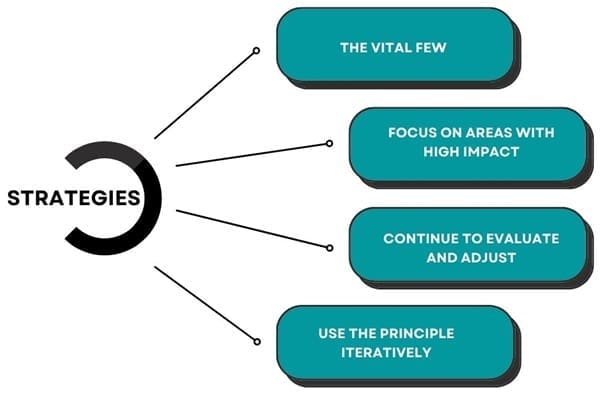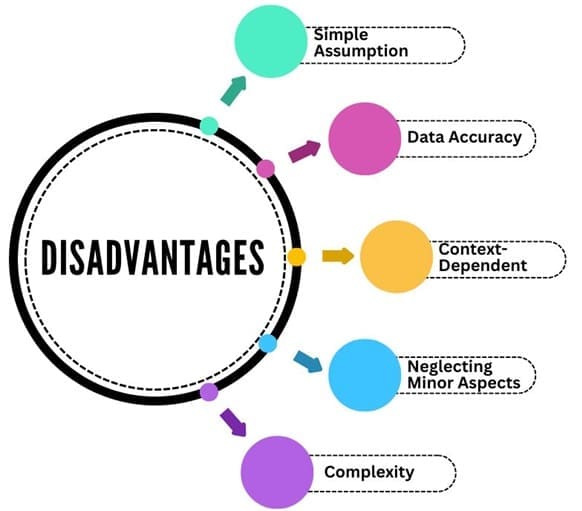Pareto Principle (80/20 rule) is a powerful concept in many fields. From business management to productivity, it has a huge impact. It suggests that 80% of the results are a result of 20% of the efforts.
The Pareto Principle is named for the Italian economist Vilfredo Pareto. It is a guideline that has helped individuals and organizations maximize their effectiveness and impact. Let’s explore what the Pareto Principle is and how to apply it in real-life scenarios.
We also call it as Pareto Rule and 80/20 Rule.
Table of contents
What is the Pareto Principle?
According to the Pareto Principle, for most outcomes, approximately 80% of results are due to 20% of causes. This means that a small number of causes can have a large impact.
The Pareto Principle is based on the idea that minorities of inputs and efforts can often lead to majorities of results or outputs.
It highlights an unequal distribution of results, whereby a few factors are responsible for a greater proportion of the outcomes. The Pareto Principle applies to many areas, including manufacturing, management and human resources.
Public, Onsite, Virtual, and Online Six Sigma Certification Training!
- We are accredited by the IASSC.
- Live Public Training at 52 Sites.
- Live Virtual Training.
- Onsite Training (at your organization).
- Interactive Online (self-paced) training,
Examples
- 20% of products generate 80% of sales revenue.
- 20% of tasks consume 80% of project resources.
- 20% of complaints account for 80% of customer dissatisfaction.
- 20% of web pages attract 80% of total site visitors.
Also Read: What is Pareto Optimality
Background of Pareto Principle
Joseph M. Juran, in the 1940s, renamed the principle after it was created by Italian economist Vilfredo Pareto. HE observed the phenomenon for the first time in the early 20th Century.
Its roots are in Pareto’s study on wealth distribution. Pareto observed that about 80% of land in Italy belonged to 20% of the population. This observation inspired Pareto to develop the Pareto Principle.
The Pareto Principle is a general observation that life’s events are not always evenly distributed.
Many CRM and coaching software programs have adopted it. The Pareto Principle is most commonly used for time management. This is because people tend to spend their time thinly instead of focusing more on the most crucial tasks. When it comes to personal time management, you could get 80% of the work output from just 20% of your working time.
Pareto Principle Applications
Here are some examples of detailed applications:
- Business management: The Pareto Principle is often used in business to optimize resource allocation. Managers may, for example, focus their efforts on the 20% of customers that contribute 80% of profits. They may also identify and prioritize the 20% of products or services that generate the most revenue.
- Quality management In quality management the Pareto Principle helps to identify and prioritise areas that need improvement. It can be used, for example, to identify the few critical defects responsible for most quality issues. Organizations can improve the overall quality of their products or services by addressing these issues first.
- Project management: The Pareto Principle is a tool that helps project managers focus their efforts on the tasks with the greatest impact on the project’s success. Project managers can identify the 20% of critical tasks responsible for 80% of the project’s completion, or they can allocate resources according to the relative importance of the tasks. This ensures that resources are used efficiently to meet project goals.
- Time management: The Pareto Principle is a tool that helps people prioritize their tasks according to importance and impact. By identifying the 20% of activities that yield 80% results, people can concentrate their energy and time on the tasks that are most aligned with their goals.
- Marketing: In marketing and sales the Pareto Principle helps to segment customers and target high-value prospects. Sales teams can focus on the 20% of leads most likely to become paying customers. This will maximize sales conversion rates. Marketers may also focus their efforts on channels or campaigns that generate the best return on investment.
Also Read: Pareto Chart in Six Sigma
Pareto Principle Strategies
To harness the power of the Pareto Principle, you need a strategic approach. Here are some tips for applying the 80/20 rule effectively:

The Vital Few
To leverage the Pareto Principle, the first step is to identify those factors that are most important to achieving the desired results. Understanding which factors are most important to achieve the desired results, whether it is customers, tasks or products, is crucial for prioritization.
Focus on areas with high-impact
After identifying the most important factors, it is crucial to focus attention and resources on areas that have a high impact. Individuals and organizations can maximize efficiency and effectiveness by concentrating their efforts in areas where they will have the greatest impact.
Continue to Evaluate and adjust
Pareto Principle’s effectiveness lies in its dynamic nature. It’s important to constantly evaluate and adapt strategies as circumstances change and more data is available. This means reassessing regularly which factors drive the most results and adapting your priorities accordingly.
Use the principle iteratively
The Pareto Principle is applicable at different levels of analysis. The principle is true whether it’s on the level of an organization, a project, or an individual. Continuous improvement is possible by focusing on the few most important factors in each context.
Advantages of Pareto Principles
Here we are going to discuss a few advantages of the Pareto Principle:

- Efficiency: This principle identifies the few most important factors that are the key to achieving a desired result. Organizations can increase their efficiency and productivity by focusing on these key areas.
- Prioritization: It helps to prioritize tasks, resources and efforts according to their impact. It ensures that resources are only allocated to those activities that have the greatest return, maximising effectiveness.
- Strategic planning: By highlighting the areas that have the greatest potential for improvement, it helps in strategic decision-making. The Pareto Principle allows organizations to create targeted strategies that address the key challenges and opportunities.
- Resource optimization: By concentrating on the most important factors, organizations can optimize resource usage and avoid waste. Cost savings and increased profitability are the result.
- Problem Solving: This tool facilitates the solution of problems by identifying their root causes. The majority of problems are caused by a few key factors. Addressing these factors can lead to sustainable solutions.
Also See: Lean Six Sigma Certification Programs, Tucson, Arizona
Disadvantages of Pareto Principles
You can find the disadvantages of the Pareto Principle below:

- Simple Assumption: The 80/20 rule is a generalization that may not accurately reflect the distribution of results. This ratio can be over-used without a proper analysis, which could lead to poor decisions.
- Data Accuracy: The Pareto Principle relies upon accurate data to identify the few most important factors. Incomplete or inaccurate data can lead to flawed conclusions and ineffective strategies.
- Context-Dependent: The application of the principle can vary depending on context and industry. The vital few factors can vary depending on the specific circumstances. This makes it difficult to apply them universally.
- Neglecting Minor Aspects: Concentrating solely on a few vital factors can lead to neglecting other important aspects. Ignoring outliers or minor factors could lead to missed opportunities or unexpected consequences.
- Complexity: To implement the Pareto Principle successfully, careful analysis and decisions are required. It can take a lot of time and resources to identify the few most important factors and develop targeted strategies.
Final Words
The Pareto Principle is a powerful tool for increasing efficiency and effectiveness across a wide range of areas. Individuals and organizations can maximize their potential with it. They can do so by understanding the unequal distribution and focusing on the few vital factors that are responsible for the majority of the results.
The 80/20 rule is a valuable tool for success in any field, whether it’s business, project or time management, quality management, etc. Vilfredo Pareto said it best, “The few vital and the many trivial.”

About Six Sigma Development Solutions, Inc.
Six Sigma Development Solutions, Inc. offers onsite, public, and virtual Lean Six Sigma certification training. We are an Accredited Training Organization by the IASSC (International Association of Six Sigma Certification). We offer Lean Six Sigma Green Belt, Black Belt, and Yellow Belt, as well as LEAN certifications.
Book a Call and Let us know how we can help meet your training needs.




















